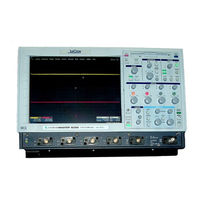LeCroy WaveMaster 8500A Manuals
Manuals and User Guides for LeCroy WaveMaster 8500A. We have 1 LeCroy WaveMaster 8500A manual available for free PDF download: Operator's Manual
LeCroy WaveMaster 8500A Operator's Manual (437 pages)
X-STREAM OSCILLOSCOPES
Brand: LeCroy
|
Category: Test Equipment
|
Size: 7.67 MB
Table of Contents
-
Introduction
19-
-
Type Styles19
-
-
Windows Help20
-
Warranty27
-
-
Warranty40
-
-
Safety47
-
-
Cooling49
-
Calibration51
-
Cleaning51
-
-
-
Dialog Boxes59
-
-
Menu Bar63
-
Dialog Area63
-
-
Installation
66 -
-
Roll Mode93
-
-
Triggering
100-
Simple Triggers104
-
SMART Triggers107
-
Width Trigger107
-
Glitch Trigger108
-
Interval Trigger110
-
State Trigger117
-
Dropout Trigger118
-
Logic Trigger119
-
Serial Trigger121
-
-
Display Formats
122-
Display Setup122
-
-
Saturation Level123
-
Show Last Trace125
-
Persistence Time126
-
-
Screen Saver127
-
XY Display131
-
-
Save and Recall
133-
-
Saving Waveforms134
-
-
Disk Utilities136
-
-
Printing138
-
Managing Files139
-
Track Views
142 -
Histograms
144-
-
Scope Process161
-
Parameter Buffer162
-
-
Histogram Peaks164
-
-
Cursors Setup166
-
Quick Display166
-
Full Setup167
-
-
Statistics171
-
Measure Modes171
-
Measure Gate176
-
Help Markers178
-
Waveform Math
216-
Math Made Easy216
-
-
To Resample217
-
-
Waveform Copy223
-
Waveform Sparser223
-
Interpolation224
-
Fast Wave Port225
-
Setup -- Case 1226
-
Setup -- Case 2226
-
Setup -- Case 3226
-
Fft232
-
Why Use FFT232
-
-
Record Length235
-
FFT Algorithms235
-
Analysis
242-
-
Mask Tests242
-
Actions243
-
-
Utilities
248-
Status248
-
Hardcopy249
-
Aux Output250
-
Date & Time250
-
Options252
-
Preferences252
-
Audible Feedback252
-
Auto-Calibration252
-
Offset Control252
-
Delay Control252
-
Trigger Counter253
-
E-Mail253
-
-
Service254
-
-
Customization
256-
-
Introduction256
-
Solutions256
-
Examples257
-
What Is Excel262
-
What Is Mathcad262
-
What Is MATLAB262
-
What Is VBS262
-
-
-
-
Variable Types291
-
Variable Names292
-
General Usage292
-
VBS Controls294
-
Summary of if297
-
Select Case297
-
While299
-
For299
-
-
Other VBS Words302
-
Functions303
-
Errors305
-
Error Handling307
-
Scripting Ideas308
-
-
-
Calling MATLAB313
-
-
-
Customdso
325 -
Labnotebook
339-
Preferences339
-
Hardcopy Setup339
-
E-Mail Setup340
-
Dda
349-
-
Channel Setup358
-
-
Channel Setup361
-
-
Read Gate363
-
Sector Pulse363
-
Servo Gate364
-
-
Setting up Zoom365
-
-
-
Overview382
-
Local Baselines383
-
Local Parameters385
-
-
Noise Parameters419
-
-
Why PRML422
-
Db Frequency424
-
Boost at Fc424
-
Group Delay425
-
Resampling ADC426
-
PLL and AGC428
-
ML Detector428
-
Sam428
-
Encoding429
-
Error Correction429
-
Advertisement
Advertisement
